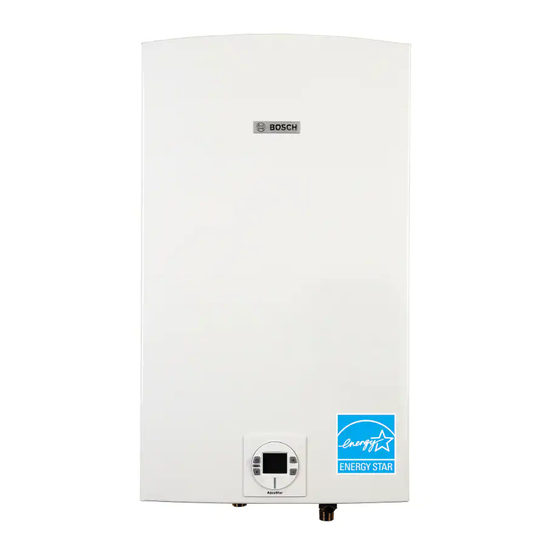Bosch Evolution 500 Service-Bulletin - Seite 2
Blättern Sie online oder laden Sie pdf Service-Bulletin für Geschirrspüler Bosch Evolution 500 herunter. Bosch Evolution 500 2 Seiten. Removing and replacing water valve
Auch für Bosch Evolution 500: Gebrauchsanweisung Handbuch (40 seiten), Installationshandbuch (6 seiten), Technisches Service-Bulletin (2 seiten), Technisches Service-Bulletin (2 seiten), Service-Bulletin (2 seiten)

6 | G3-33 | 715ES, C800ES, C920ES, C920ESC, 2400ES, 2700ES, Evolution 500, Integra 500
7.
Check that the P1 and P2 fan speeds are set to the correct
levels in accordance with the vents lengths and altitude. Please
consult the Installation Manual for more information.
WARNING: Steps 8 - 17 include troubleshooting that
should ONLY be performed by a qualifi ed professional.
8.
Measure gas pressure under full load with manometer. See
Bulletin Measuring Gas Pressure or Installation Manual for
details. Have gas technician call Bosch Technical Support from
heater to report readings. Record gas pressure readings below:
a) Static: ____"WC
b) Tankless Maximum Power: _______"WC
c) House Full Load: _______"WC
If Full Load or Maximum Power gas pressure is below 3.5" WC
(NG) or 8.0" WC (LP), address gas line size or regulated
system pressure to correct.
9.
Make sure there is no air in the gas line. Although more
frequent in new installs, this can happen if work is done on the
gas line or after a fuel delivery. If you suspect this, contact a
certifi ed gas technician in your area.
10. Is the unit making any odd grunting or whistling noises? If so, it
may be an indication the fuel/air mixture is incorrect. Fuel/air
mixture can only be adjusted with the use of a combustion gas
analyzer. See Bulletin Measuring & Adjusting CO₂ for adjusting
CO₂.
11. If there is no evidence of a heat exchanger leak, inspect for
signs of condensation:
a) Remove the gas valve inspection cover and inspect the area
for any signs of moisture or debris. Make sure the cork
gasket is not damaged and replace it if it shows any signs of
damage. Moisture or rust spots indicate a long term conden-
sation issue that may be causing the error codes.
b) Remove the plastic air supply duct and inspect the fan for
signs of moisture.
c) Remove the heat exchanger site window and using a
flashlight, look for any signs of moisture and debris in the
heat exchanger chamber.
d) Look for any signs that the ceramat burner may be damaged.
Ceramat material that sits above the level of the tray may
indicate damage.
Signs of moisture or damage to the ceramat burner may
require the removal of the heat exchanger for further
inspection and investigation of a potential water leak.
12. Inspect ignition wires and fl ame sensor wire.
Data subject to change without notice | Printed in the USA | BTC 710002326 A | 03.2013
13. Inspect and clean electrodes and fl ame rod, see Bulletin
Cleaning & Replacing Ignition Group. Verify spacing between
electrodes is no greater than 5.5mm or ¼". Inspect the ceramic
insulation on electrodes for cracks. Replace electrodes if
damage is present.
14. Measure the voltage to the gas valve on the left hand pair of
wires and the right hand pair of wires. Normally, you will fi nd
24VDC when the unit is running or trying to fi re.
15. Measure the resistance of each coil on the gas valve. You should
see 80 Ω on the left pair of pins and 160 Ω on the right pair of
pins.
16. Inspect the wiring harness for defects. Reseat the harness
connections on the control board.
—
Check for continuity between ground on the control and
the heater chassis.
If following the procedures did not resolve the problem,
report the troubleshooting results to Bosch Technical
Support. Performing the troubleshooting prior to calling
will speed your call and assist in determining the cause
and solution to the problem.
Service bulletin
Bosch Thermotechnology Corp.
50 Wentworth Avenue
Londonderry, NH 03053
Tel: 1-866-330-2730
Fax: 1-603-965-7581
www.bosch-climate.us
Bosch Thermotechnology Corp.
